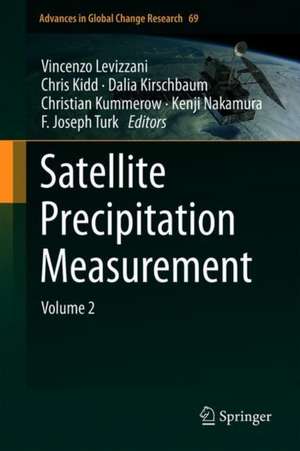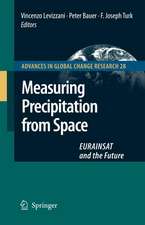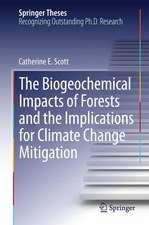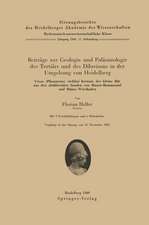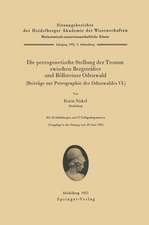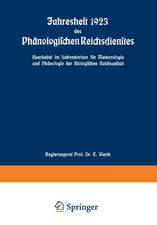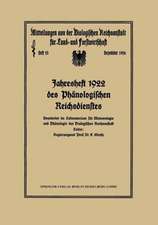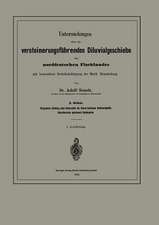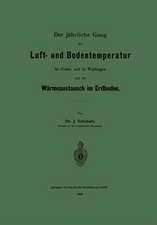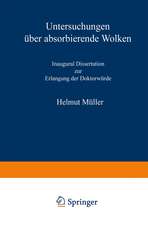Satellite Precipitation Measurement: Volume 2: Advances in Global Change Research, cartea 69
Editat de Vincenzo Levizzani, Christopher Kidd, Dalia B. Kirschbaum, Christian D. Kummerow, Kenji Nakamura, F. Joseph Turken Limba Engleză Hardback – 15 apr 2020
The book will be of interest to meteorologists, hydrologists, climatologists, water management authorities, students at various levels and many other parties interested in making use of satellite precipitation data sets.
| Toate formatele și edițiile | Preț | Express |
|---|---|---|
| Paperback (1) | 869.80 lei 38-44 zile | |
| Springer International Publishing – 15 apr 2021 | 869.80 lei 38-44 zile | |
| Hardback (2) | 1036.54 lei 3-5 săpt. | |
| Springer International Publishing – 15 apr 2020 | 1036.54 lei 3-5 săpt. | |
| Springer International Publishing – 11 apr 2020 | 1062.75 lei 38-44 zile |
Din seria Advances in Global Change Research
- 15%
 Preț: 636.12 lei
Preț: 636.12 lei -
 Preț: 439.83 lei
Preț: 439.83 lei - 18%
 Preț: 895.45 lei
Preț: 895.45 lei - 15%
 Preț: 648.24 lei
Preț: 648.24 lei - 18%
 Preț: 894.16 lei
Preț: 894.16 lei - 18%
 Preț: 963.60 lei
Preț: 963.60 lei - 18%
 Preț: 1239.49 lei
Preț: 1239.49 lei - 15%
 Preț: 649.71 lei
Preț: 649.71 lei - 18%
 Preț: 1243.78 lei
Preț: 1243.78 lei - 18%
 Preț: 1114.02 lei
Preț: 1114.02 lei - 15%
 Preț: 648.89 lei
Preț: 648.89 lei - 18%
 Preț: 960.78 lei
Preț: 960.78 lei - 15%
 Preț: 643.99 lei
Preț: 643.99 lei - 18%
 Preț: 1834.44 lei
Preț: 1834.44 lei - 15%
 Preț: 649.06 lei
Preț: 649.06 lei - 18%
 Preț: 955.70 lei
Preț: 955.70 lei - 18%
 Preț: 956.03 lei
Preț: 956.03 lei - 18%
 Preț: 1232.26 lei
Preț: 1232.26 lei - 18%
 Preț: 955.88 lei
Preț: 955.88 lei - 18%
 Preț: 959.19 lei
Preț: 959.19 lei - 18%
 Preț: 944.82 lei
Preț: 944.82 lei - 18%
 Preț: 1105.19 lei
Preț: 1105.19 lei - 15%
 Preț: 644.49 lei
Preț: 644.49 lei - 15%
 Preț: 643.99 lei
Preț: 643.99 lei - 18%
 Preț: 1841.54 lei
Preț: 1841.54 lei - 18%
 Preț: 1225.94 lei
Preț: 1225.94 lei - 18%
 Preț: 954.62 lei
Preț: 954.62 lei - 5%
 Preț: 1414.80 lei
Preț: 1414.80 lei
Preț: 1036.54 lei
Preț vechi: 1264.07 lei
-18% Nou
Puncte Express: 1555
Preț estimativ în valută:
198.34€ • 207.64$ • 164.11£
198.34€ • 207.64$ • 164.11£
Carte disponibilă
Livrare economică 17-31 martie
Preluare comenzi: 021 569.72.76
Specificații
ISBN-13: 9783030357979
ISBN-10: 303035797X
Pagini: 725
Ilustrații: XCIII, 725 p. 300 illus., 251 illus. in color.
Dimensiuni: 155 x 235 mm
Greutate: 1.5 kg
Ediția:1st ed. 2020
Editura: Springer International Publishing
Colecția Springer
Seria Advances in Global Change Research
Locul publicării:Cham, Switzerland
ISBN-10: 303035797X
Pagini: 725
Ilustrații: XCIII, 725 p. 300 illus., 251 illus. in color.
Dimensiuni: 155 x 235 mm
Greutate: 1.5 kg
Ediția:1st ed. 2020
Editura: Springer International Publishing
Colecția Springer
Seria Advances in Global Change Research
Locul publicării:Cham, Switzerland
Cuprins
SECTION 4 Validation: Chapter 25. The IPWG satellite precipitation validation effort.- Chapter 26. The GPM Ground Validation Program.- Chapter 27. The GPM DPR Validation Program.- Chapter 28. Error and uncertainty characterization.- Chapter 29. Multiscale evaluation of satellite precipitation products: Effective resolution of IMERG.- Chapter 30. Remote sensing of orographic precipitation.- Chapter 31. Integrated multi-satellite evaluation for the Global Precipitation Measurement: Impact of precipitation types on spaceborne precipitation estimation.- Chapter 32. Hydrologic validation and flood analysis.- Chapter 33. Global-scale evaluation of 22 precipitation datasets using gauge observations and hydrological modeling.- Chapter 34. OceanRAIN – The global ocean surface-reference dataset for characterization, validation and evaluation of the water cycle.- SECTION 5 Observed Characteristics of Precipitation: Chapter 35. GPCP and the global characteristics of precipitation.- Chapter 36. Global snowfall detection and measurement.- Chapter 37. Snowfall detection by spaceborne radars.- Chapter 38. On the duration and lifecyle of precipitation systems in the tropics.- Chapter 39. Observational characteristics of warm-type heavy rainfall.- Chapter 40. Satellite precipitation measurement and extreme rainfall.- Chapter 41. Rainfall trends in East Africa from an ensemble of IR-based satellite products.- Chapter 42. Heavy precipitation systems in the Mediterranean area: The role of GPM.- Chapter 43. Dryland precipitation climatology from satellite observations.- Chapter 44. Haifall detection.- Chapter 45. Improving high-latitude and cold region precipitation analysis.- Chapter 46. Latent heating retrievals from satellite observations.- SECTION 6 Applications: Chapter 47. Operational applications of Global Precipitation Measurement observations.- Chapter 48. Assimilation of precipitation observations from space into numerical weather prediction (NWP).- Chapter 49. Precipitation ensemble data assimilation in NWP models.- Chapter 50. PERSIANN-CDR for hydrology and hydro-climatic applications.- Chapter 51. Soil moisture and precipitation: The SM2RAIN algorithm for rainfall retrieval from satellite soil moisture.- Chapter 52. Drought risk management using satellite-based rainfall estimates.- Chapter 53. Two decades of urban hydroclimatological studies have yielded discovery and societal benefits.- Chapter 54. Validation of climate models.- Chapter 55. Extreme precipitation in the Himalayan landslide hotspot.- Chapter 56. The value of satellite rainfall estimates in agriculture and food security.- Chapter 57. Using satellite estimates of precipitation for fire danger rating.- Chapter 58. Variability of satellite sea surface salinity under rainfall.
Notă biografică
Vincenzo Levizzani is Director of Research at the Institute of Atmospheric Sciences and Climate of the National Council of Research in Bologna, Italy, and Professor of Cloud Physics at the University of Bologna. His research interests concentrate on cloud structure, precipitation measurement from space, regional climatology of clouds and precipitation and new space mission concept design. He was among the co-founders of the International Precipitation Working Group and has collaborated to clouds and precipitation missions of the European Organization for the Exploitation of Meteorological Satellites (EUMETSAT) and the European Space Agency (ESA). He is author of several hundreds peer-reviewed journal publications, book contributions and scientific reports, and has served in several high-level committees of WMO, NASA, ESA, EUMETSAT, KMA, European Commission, etc.
Christopher Kidd obtained a BSc in Geography from the University of Nottingham,followed by a PhD from the University of Bristol. He has been at the forefront of satellite precipitation estimation over the last 30 years, focusing upon retrieval schemes from both passive microwave observations and multi-sensor observations, together with the verification, validation and inter-comparison of satellite estimates and surface measurements.
Dalia B. Kirschbaum is a Research Physical Scientist in the Hydrological Sciences Lab at NASA Goddard Space Flight Center in Greenbelt, Maryland. She has served as the Global Precipitation Measurement (GPM) Mission Associate Deputy Project Scientist for Applications since 2009, where she leads a team of outreach and applications specialists to provide scientific support for applications research and activities. Her research interests center on the application of GPM data to rainfall-triggered landslide modeling efforts, including a global landslide situational awareness system that is being used worldwide. She has authored over forty papers on the topic of applying remotely sensed surface and precipitation information to landslide hazard models at multiple spatial and temporal scales.
Christian D. Kummerow is Professor of Atmospheric Science at Colorado State University where he also serves as Director of the Cooperative Institute for Research in the Atmosphere (CIRA). He has spent much of his career studying the global water and energy cycles. He is particularly interested in observing the global water cycle and its uncertainties – how uncertainties relate to physical aspects of the atmosphere, and thus the fundamental processes underlying precipitation. From 1997 to 2000 he served as the TRMM Project Scientist and continues to serve on the science steering teams of both the TRMM as the Global Precipitation Mission where he leads the team responsible for the passive microwave rainfall products. He has authored over one hundred peer reviewed journal publications related to global clouds and the hydrologic cycle.
Kenji Nakamura is Professor of the Department of Economics on Sustainability, Faculty of Economics in Dokkyo University, Japan. Before Dokkyo University, he was a professor at Nagoya University, Japan, and he was the Director of the Hydrospheric-Atmospheric Research Center, Nagoya University during 2001-2005 and 2011-2013. His specialization is in microwave remote sensing techniques, multi-wavelength and dual-polarization radar techniques, and precipitation science. He led the Tropical Rainfall Measuring Mission (TRMM) and the Global Precipitation Measurement (GPM) projects in Japan. He served as a Member of the Board of Directors of the Meteorological Society of Japan and a Senior advisor of the Earth Observation Research Center, the Japan Aerospace Exploration Agency. He is a recipient of Fujiwhara Award of the Japan Meteorological Society.
F. Joseph Turk is a radar scientist with the Jet Propulsion Laboratory, California Institute of Technology, Pasadena, CA. His research has been related to a variety passive and active microwave measurements and remote sensing techniques. He has been involved with NASA satellite measurements for precipitation (GPM, TRMM) and scatterometry (QuikSCAT, RapidScat), a number of airborne field campaigns for studying convective clouds and hurricanes, and a member of the science team for the Radio Occultations though Heavy Precipitation (ROHP) instrument. He has been a member of the AMS Satellite Meteorology and Oceanography Committee, and Editor for the AMS Journal of Hydrometeorology and active in the IPWG since its inception.
Christopher Kidd obtained a BSc in Geography from the University of Nottingham,followed by a PhD from the University of Bristol. He has been at the forefront of satellite precipitation estimation over the last 30 years, focusing upon retrieval schemes from both passive microwave observations and multi-sensor observations, together with the verification, validation and inter-comparison of satellite estimates and surface measurements.
Dalia B. Kirschbaum is a Research Physical Scientist in the Hydrological Sciences Lab at NASA Goddard Space Flight Center in Greenbelt, Maryland. She has served as the Global Precipitation Measurement (GPM) Mission Associate Deputy Project Scientist for Applications since 2009, where she leads a team of outreach and applications specialists to provide scientific support for applications research and activities. Her research interests center on the application of GPM data to rainfall-triggered landslide modeling efforts, including a global landslide situational awareness system that is being used worldwide. She has authored over forty papers on the topic of applying remotely sensed surface and precipitation information to landslide hazard models at multiple spatial and temporal scales.
Christian D. Kummerow is Professor of Atmospheric Science at Colorado State University where he also serves as Director of the Cooperative Institute for Research in the Atmosphere (CIRA). He has spent much of his career studying the global water and energy cycles. He is particularly interested in observing the global water cycle and its uncertainties – how uncertainties relate to physical aspects of the atmosphere, and thus the fundamental processes underlying precipitation. From 1997 to 2000 he served as the TRMM Project Scientist and continues to serve on the science steering teams of both the TRMM as the Global Precipitation Mission where he leads the team responsible for the passive microwave rainfall products. He has authored over one hundred peer reviewed journal publications related to global clouds and the hydrologic cycle.
Kenji Nakamura is Professor of the Department of Economics on Sustainability, Faculty of Economics in Dokkyo University, Japan. Before Dokkyo University, he was a professor at Nagoya University, Japan, and he was the Director of the Hydrospheric-Atmospheric Research Center, Nagoya University during 2001-2005 and 2011-2013. His specialization is in microwave remote sensing techniques, multi-wavelength and dual-polarization radar techniques, and precipitation science. He led the Tropical Rainfall Measuring Mission (TRMM) and the Global Precipitation Measurement (GPM) projects in Japan. He served as a Member of the Board of Directors of the Meteorological Society of Japan and a Senior advisor of the Earth Observation Research Center, the Japan Aerospace Exploration Agency. He is a recipient of Fujiwhara Award of the Japan Meteorological Society.
F. Joseph Turk is a radar scientist with the Jet Propulsion Laboratory, California Institute of Technology, Pasadena, CA. His research has been related to a variety passive and active microwave measurements and remote sensing techniques. He has been involved with NASA satellite measurements for precipitation (GPM, TRMM) and scatterometry (QuikSCAT, RapidScat), a number of airborne field campaigns for studying convective clouds and hurricanes, and a member of the science team for the Radio Occultations though Heavy Precipitation (ROHP) instrument. He has been a member of the AMS Satellite Meteorology and Oceanography Committee, and Editor for the AMS Journal of Hydrometeorology and active in the IPWG since its inception.
Textul de pe ultima copertă
This book offers a complete overview of the measurement of precipitation from space, which has made considerable advancements during the last two decades. This is mainly due to the Tropical Rainfall Measuring Mission (TRMM), the Global Precipitation Measurement (GPM) mission, CloudSat and a carefully maintained constellation of satellites hosting passive microwave sensors. The book revisits a previous book, Measuring Precipitation from Space, edited by V. Levizzani, P. Bauer and F. J. Turk, published with Springer in 2007. The current content has been completely renewed to incorporate the advancements of science and technology in the field since then. This book provides unique contributions from field experts and from the International Precipitation Working Group (IPWG).
The book will be of interest to meteorologists, hydrologists, climatologists, water management authorities, students at various levels and many other parties interested in making use of satellite precipitation data sets.
The book will be of interest to meteorologists, hydrologists, climatologists, water management authorities, students at various levels and many other parties interested in making use of satellite precipitation data sets.
Caracteristici
Offers state-of-the-art intelligence on how to interpret precipitation data sets Contains first-hand teaching material for undergraduate and graduate students Highlights the successes of the community whilst indicating the open science, technology issues and future challenges
